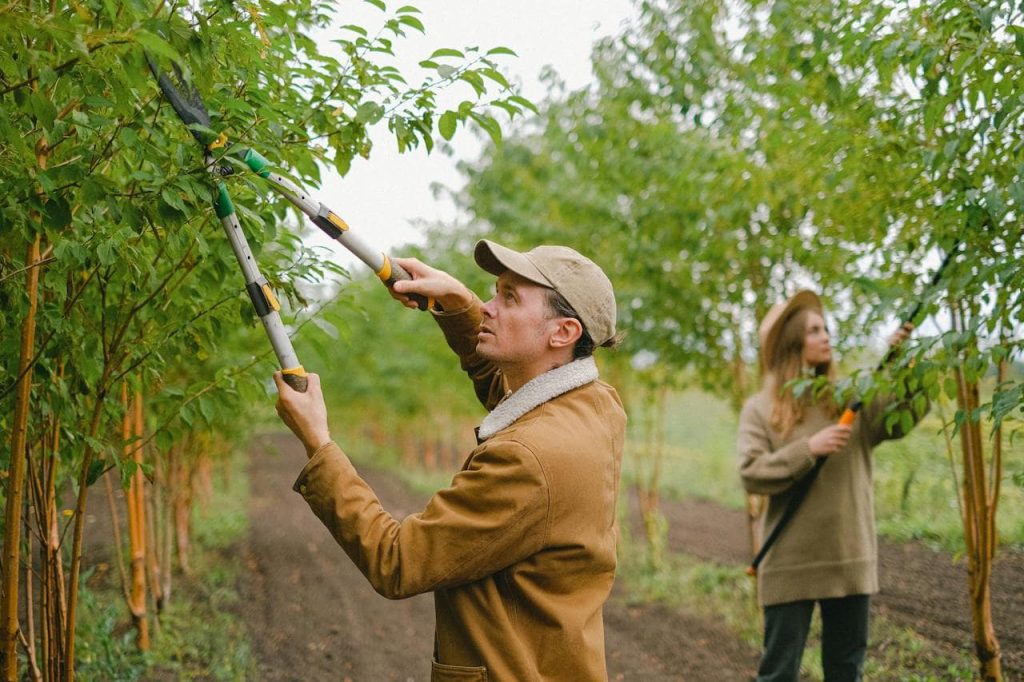
The practice of tree pruning is an essential part of maintaining our urban and suburban green spaces. Far from being solely about aesthetics, this process delivers significant environmental benefits, improving not only the health and lifespan of trees but also contributing to the overall wellbeing of the ecosystem. Let’s explore the main types of tree pruning and the benefits each practice provides to our environment.
The Importance of Tree Pruning
Tree pruning is, quite simply, about removing select branches from a tree for various reasons. These can include encouraging growth, maintaining tree health, ensuring safety by removing hazardous branches, and shaping trees for aesthetic reasons. There are four main types of tree pruning, each with its unique impact on tree health and aesthetics.
Raising the Canopy
Canopy raising involves removing the lower branches of a tree to provide clearance for pedestrians, vehicles, or buildings. This type of pruning is common in suburban and urban environments. By raising the canopy, trees can coexist harmoniously in populated areas, preventing hazards while improving visibility and access.
Thinning the Canopy
Canopy thinning involves removing selected branches throughout the tree’s crown to improve light penetration and air movement. This process reduces the density of the tree’s canopy, promoting healthy tree growth and structure. It also helps prevent diseases and pests, as better air circulation means a drier environment where fungi and bacteria struggle to thrive.
Reducing the Canopy
Canopy reduction involves reducing the height or spread of a tree by removing specific branches. Unlike topping (an harmful practice where the top of the tree is indiscriminately chopped off), canopy reduction is a more gentle approach that respects the tree’s natural shape and promotes its health. It’s employed, for instance, to prevent a tree from interfering with power lines.
Cleaning the Canopy
Canopy cleaning means removing the dead, diseased, or dying branches from a tree. This type of pruning promotes tree health by preventing diseases from spreading and eliminating breeding grounds for pests. It also makes the tree look more appealing and prevents hazards from falling branches.
Essential Equipment for Tree Pruning
To effectively execute the art of tree pruning and reap its environmental benefits, using the right equipment is crucial. Loppers, a fundamental tool in any gardener’s arsenal, are perfect for trimming and cutting branches up to 2 inches in diameter. These long-handled cutting tools come in two styles: bypass loppers, which are ideal for cleanly pruning living growth, and anvil loppers, better suited for removing dead wood. In addition to loppers, other necessary equipment includes handheld pruning shears for smaller branches, pruning saws for larger limbs, and, in some cases, pole saws for reaching higher branches or those that are difficult to access. Equipped with these essential tools, you’ll be well-prepared for efficient and effective tree pruning, helping to cultivate a flourishing and sustainable environment.
Environmental Benefits of Tree Pruning
Tree pruning isn’t just for the trees’ benefit. It offers multiple environmental advantages that contribute to healthier, sustainable ecosystems.
Improving Air Quality
Healthy trees are excellent absorbers of carbon dioxide, a major greenhouse gas. Through the process of photosynthesis, trees convert carbon dioxide into oxygen, significantly improving air quality. Regular tree pruning keeps our trees at their healthiest, enabling maximum carbon dioxide absorption and oxygen production.
Promoting Biodiversity
Pruned, healthy trees provide an ideal habitat for various bird and insect species. A single tree can become a vibrant eco-system on its own. By pruning trees and preserving their health, we encourage biodiversity, contributing to healthier, more balanced local ecosystems.
Decreasing Soil Erosion
Trees’ root systems play a crucial role in preventing soil erosion, particularly on slopes or riverbanks. When trees are well-pruned and healthy, their root systems are stronger and more efficient in holding the soil together.
Temperature Regulation
Trees can regulate temperatures by providing shade and releasing water vapor during transpiration. Without regular pruning, a tree’s foliage can become so dense that it impedes the flow of cool air, reducing its effectiveness in providing heat relief. Proper pruning enhances this natural form of air-conditioning, contributing to cooler urban areas.
Let’s Promote Healthy Urban Forests
Pruning is an integral part of urban tree management that produces a domino effect of benefits – from the individual tree’s health to the ecosystem it supports. These manifold returns of tree pruning remind us of our interconnectedness with nature and the need for responsible stewardship of our environment. Through better understanding and widespread practice of correct tree pruning, we can promote not just healthier individual trees, but also more vibrant, healthier, and sustainable urban forests.
Promoting Water Conservation
In addition to the above-mentioned environmental benefits, healthy trees play a crucial role in conserving water. The shade provided by trees slows down water evaporation from lawns and other vegetation, reducing the need for frequent watering. Moreover, trees also help filter rainwater and recharge the groundwater table, contributing to the conservation of this vital resource.
Waste Reduction
Apart from being environmentally friendly, regular tree pruning also aids in waste reduction. Pruned branches and leaves can be converted into mulch or compost, reducing the amount of green waste entering our landfills. This compost improves soil health, retaining moisture and providing valuable nutrients for other plants. Utilizing pruned materials in this way closes the loop of organic waste production, making it a completely sustainable process.
Enhancing the Visual Appeal of the Environment
Our environments’ visual appeal matters, too, and pruned trees undoubtedly enhance this. Pruning keeps trees balanced, shapely, and proportionate, creating an aesthetically pleasing look that boosts the overall impression of our neighborhood and city. Numerous studies have shown that well-maintained, tree-rich environments have a positive effect on mental health, reduce stress, and improve general wellbeing, making them desirable places to live and work.
Conclusion: The Win-Win of Tree Pruning
In conclusion, tree pruning offers a win-win scenario for everyone—people and nature alike. It helps maintain beautiful, safe, and sustainable surroundings. It keeps our trees healthy, ensuring they live long lives, sequestering carbon, providing shade, conserving water, and nurturing biodiversity. As we continue to urbanize and reshape our landscapes at an unprecedented pace, it is more crucial than ever to integrate tree pruning into our regular landscape maintenance practices, recognizing it as more than just an aesthetic or safety measure, but a meaningful way to contribute to our planet’s health and resilience.




Recent Comments